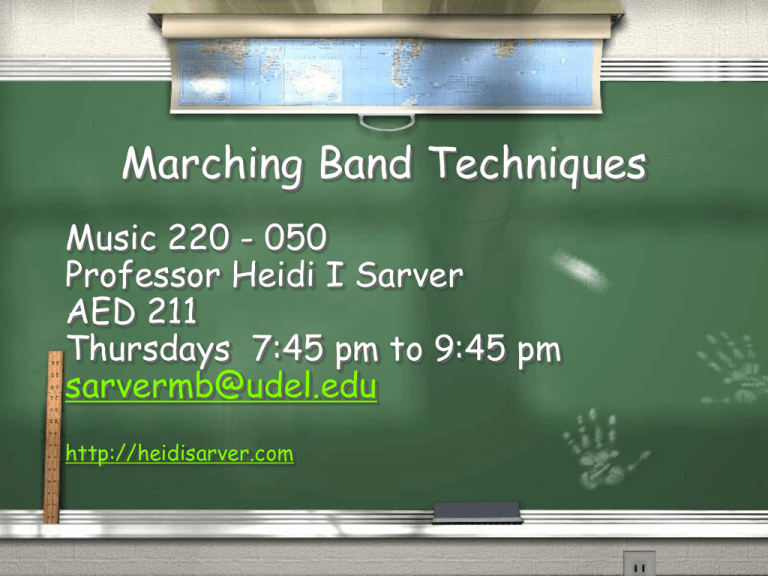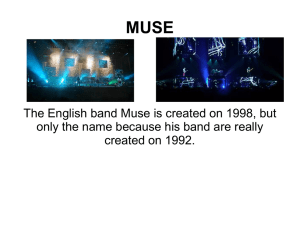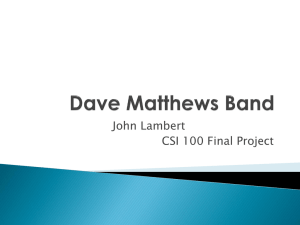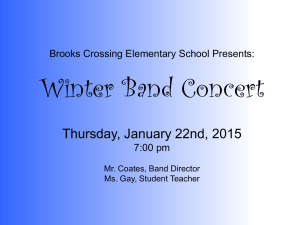
Marching Band Techniques
Music 220 - 050
Professor Heidi I Sarver
AED 211
Thursdays 7:45 pm to 9:45 pm
sarvermb@udel.edu
http://heidisarver.com
To
Goal -
learn general techniques of
putting a show together.
To understand my thoughts and
philosophies, and why we do the
things we do.
To prepare you to create a similar
program in your future.
A) When you create a show, who are
you ultimately trying to design for?
(1)
Students in the band
(2)
Football Fans
(3)
Competition Audience
(4)
Parents
(5)
Judges
(6)
Community Audience
(7)
Artistic Community
HIS goal: to provide an experience
for the students. With this in mind:
If
the show succeeds with the
audience, then the band succeeds!
The students experience success
through a positive performance.
The UDMB shows are designed
with the audience in mind.
When
our audience is convinced, then
the band is convinced.
B) What kind of different Marching
Band styles are there?
(1) Traditional College High Step Band
(2) Formation and/or Picture Show Band
(3) Corps Style Band
(4) Military Parade Band
(5) Military “Precision Drill” Field Show Band
(6) Southern “Dance” Style (Florida A&M Band)
(7) Football Halftime Show Band
(8) Competition Style Band
(9) Pep Band
(10) Combination Band: UDMB is the-- “Steal from anyone
and everyone you can band” (HIS STYLE)
C) Other considerations:
(1)
Is the band primarily for Football Halftimes,
Competition or other?
(2) Will there be many rehearsals outside of
school?
(3) Will Band Students be able to participate in
Athletic programs?
(4) Will Students in the BAND PROGRAM be
expected and/or required to participate in
Marching Band?
D) What Style is best?
Whatever
style of program the
director can produce with the most
success is the appropriate style for
that program.
E) When we begin to develop a band
show, what do we want to accomplish,
and what do we use to accomplish it.
(WATCH
DVD)
Shields and Yarnell
Why
did we watch that tape? What was
the story? The message?
What is the primary goal of any
performance? Any Class? Any Instruction?
To
Get a response.
What are the responses that we
are working to achieve?
(1) Clapping
(2) Laughing
(3) Cheering
(4) Standing
(5) Crying
(6) Clapping along with music
(7) Dancing, moving
(8) Audience interacting with each other.
(9) Dead silence….to be in awe.
And ultimately... We want the audience to
FEEL the performance. What do we want
them to feel?
PRIDE
humor
& comedy (EASIEST)
sadness & solemness (MOST
DIFFICULT)
energy & enthusiasm
What effects were used in this
performance to get a response?
(1)
a beginning, development, and
recapitulation
(2) emotion
(3) humor & comedy
(4) sadness & solemnity
(5) energy & enthusiasm
(6) involve audience
(7) applause factors--audience reaction
What effects were used in this
performance to get a response?
(8)
(9)
(10)
(11)
(12)
(13)
(14)
(15)
contrast--mood change
element of surprise
telling a story
project emotion from performers
facial expressions (VERY IMPORTANT)
use of color
sex appeal (Careful - don't over do it)
subtlety vs. exaggeration
What effects were used in this
performance to get a response?
(16)
(17)
(18)
(19)
segmentation
unity vs. contrast; soloist vs. ensemble
simplicity - simple, yet effective
staging - the field is just one big
stage
(20) variety of sounds and sights
(21) trade – offs (Sacrifice music ideas,
standards, etc for visual effect and vice
versa
What effects were used in this
performance to get a response?
(22) sequencing
(Ripple effect – fast ripple
or sequence by count
(23) dance routine
(24) TIMING
(25) coordination of music and movement –
changing music to add impact that supports
visual
(26) Props
Other Questions to Consider:
A)Marching
Band is one of many art
forms that combine Music and
Movement. What are the others?
Ballet
Opera, Musical
Ice Skating
Gymnastics
Film
What Makes the Marching Band
Art-form unique?
The
performers provide both the
music and the movement.
What are the basic ingredients
to a great program.
There are many to consider. Here are
several that have impacted the UDMB:
(1) Show Selection – Repertoire, effects,
showmanship, etc.
(2) Scheduling (Providing performance
opportunities that give members the
experience.
(3) Great Staff who can create and teach
the many components.
What are the basic ingredients
to a great program.
(4) Systematic
approach to teaching the
material
(5) Strong Music Program, Strong Visual
Program
(6) Promotion of the program
(7) Developing the attitude, the
environment, the magical feeling about the
ensemble
Use
of video tapes, appropriate songs, etc. *







